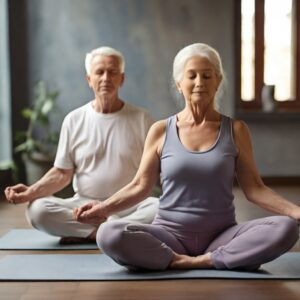Hey there! I bet you’re wondering how something like yoga, often shown through pictures of young, super-flexible people, fits into the world of our beloved seniors. Well, it’s about time we chat about the magic of asanas for those in their golden years, and why you, at the vibrant age of 20, might want to introduce them to your folks or grandparents. Trust me, it’s a lifestyle shift that can significantly brighten and improve their everyday life.
Understanding Yoga’s Gifts

Yoga presents a wide range of benefits that extend beyond physical exercise, it is particularly advantageous for seniors in managing the natural aging process. As we grow older, the risk of reduced mobility and balance issues tend to increase, potentially leading to a greater incidence of falls and injuries. By regularly engaging in yoga, seniors can enhance their sense of balance, flexibility, and muscular strength. These are key components for maintaining an active lifestyle and minimizing the risk of falls, which are common concerns for the aging population.
Yoga’s gentle, low-impact poses allow for gradual strengthening of the muscles without putting undue stress on the joints, making it an ideal form of exercise for those who may be dealing with arthritis or osteoporosis. As seniors continue to practice, they often discover an improvement in their range of motion, which can help in performing daily activities with greater ease. This can lead to prolonged independence, allowing seniors to manage their own care for longer periods.
But the gifts of yoga do not stop at physical benefits. It is also a profound source of mental and emotional relief. Seniors are not immune to feelings of stress, anxiety, or depression, which can affect one’s quality of life regardless of age. Yoga incorporates mindfulness and meditative practices that promote a calm, centered state of being. Through controlled breathing techniques (pranayama) and meditation (dhyana), yoga helps reduce stress levels and cultivate a sense of inner peace. This tranquility can have a positive impact on mental health, potentially alleviating symptoms of depression and anxiety by fostering a balanced state of mind.
Yoga sessions also provide a sense of community and social engagement, factors that are crucial for maintaining mental well-being in older age. By attending classes or group practices, seniors can interact with their peers, share experiences, and feel part of a supportive environment, further amplifying the mental health benefits of the practice.
As we delve into the various asanas and breathing exercises, we should bear in mind that our objective is to enrich their mental landscape. The practice of yoga offers a holistic approach to health, treating the mind, body, and spirit as interconnected elements of wellbeing. It is this comprehensive care that makes yoga an invaluable tool for people as they enter into their senior years.
Easy Asanas to Begin With
Before you suggest grandma jump into a backbend, let’s introduce some beginner-friendly poses. Remember, it’s important to start with gentleness and patience, respecting the body’s pace.
Tadasana
This is the mama bear of yoga asanas. It might look like just standing, but it’s a foundation pose that improves posture and balance.
Stand with feet firmly planted hip-width apart.
Ears, shoulders, and hips should align, forming a straight line.
Extend arms alongside the body, palms facing inward.
Engage core muscles gently and breathe evenly.
Balasana
Ideal for relaxation, Child’s Pose is a soothing hug for the body, stretching the back gently.
Kneel on the mat with big toes touching and knees wide apart.
Lower the torso between thighs and extend arms forward.
Rest the forehead on the mat and relax into the pose.
Bhujangasana
This gentle backbend is a boon for spinal flexibility, easing stiffness in the lower back.
Lie face down, palms under shoulders.
Press into palms, lifting head and chest while keeping elbows close to the body.
Invigorate the lower back muscles but avoid straining.
Vrksasana
Balance and concentration come together in Tree Pose, fostering stronger ankles and a focused mind.
Begin in Mountain Pose.
Shift weight onto one foot, pressing it firmly down.
Place the other foot on the inner thigh or calf (avoid the knee joint).
Bring palms together at heart center or raise overhead for more balance work.
Virabhadrasana II
Channel inner strength with this pose that enhances leg power and opens hips.
Step feet wide apart, raising arms to shoulder height.
Turn one foot out by 90 degrees and bend into the corresponding knee.
Direct gaze over the outstretched hand, keep the torso upright.
Marjaryasana and Bitilasana
This duo nurtures spine health and abdominal strength, as they smoothly transition from one to the other.
Start on hands and knees, aligning wrists under shoulders, knees under hips.
Inhale, drop the belly towards the mat, lift head and tailbone (Cow).
Exhale, round the spine towards the ceiling, tuck chin (Cat).
Flow between these two with each breath.
Paschimottanasana
We’re looking at a seated asana that stretches the backside of the body, from the spine to the hamstrings.
Sit with legs stretched in front.
Inhale and raise arms overhead.
Exhale and hinge forward from the hips, extending hands towards toes.
Instead of pushing, let gravity assist in the deepening stretch.
